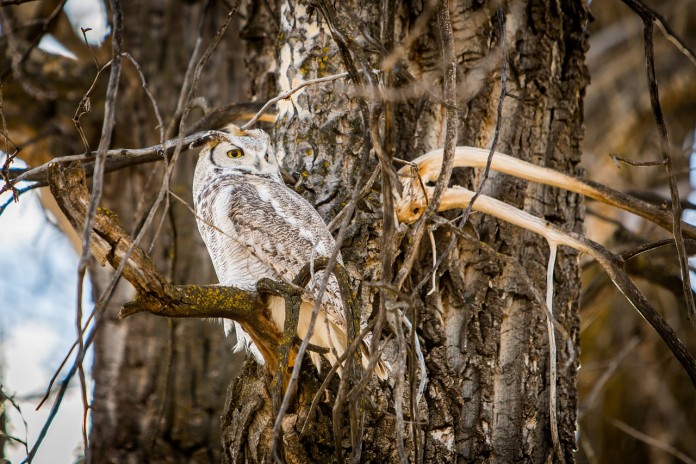On Thursday morning, Nov. 10, I awoke at 5:30 a.m. I closed my eyes and tried to get back to sleep. A few minutes later I heard a low muffled sound. In a fog of semi-consciousness I assumed the dog was snoring.
But after a few minutes, I realized the sound was coming from outside the bedroom window. By now I had processed the sound. It was a series of “hoos,” four, five, or six at a time.
It was a great horned owl, singing from a tree in the backyard not far from the house. I grabbed a flashlight and stepped outside to see if I could find it. Just then a truck rumbled by.
Another try
Apparently, that spooked the owl because silence ensued. I gave it a few minutes and the silence continued. Then just as I turned to go back to bed, I heard the owl again.
It had flown silently to a wooded hillside about a hundred yards below the house. Now two owls sang.
First the deeper voiced male called, then the female’s higher pitched voice answered. Dueting is one way horned owls strengthen the pair bond for the upcoming nesting season.
This observation should not have surprised me. Though I often hear owls singing nearby, I’d never had one in the yard before.
But just the previous day, a murder of crows was raising a ruckus on the very same hillside from which the owls sang. I even said to my wife at the time, “Bet they found an owl roosting down there.”
(Crows and other smaller birds often mob and harass owls to send a message: “We see you. You can’t surprise us. So go away.” Usually the owl leaves to find another roost site.)
Wooing the female
Over the next six to eight weeks, the male will continue to woo the female. He will feed her. He will perform noisy aerial displays. He will defend her. They will duet.
Eventually they will get serious and select a nest. Great horned owls are among the earliest nesters. They don’t build their own nests; they take over an old nest.
Often it’s an old red-tailed hawk or crow nest; occasionally they use a large tree cavity. If the female is experienced, she may use the same nest she used the previous year.
Great horned owls sit atop the food chain. They eat everything from insects, crows, flying squirrels, cats and tiny toy dogs to skunks, raccoons and porcupines, though mice, rats and cottontails comprise most of their diet.
Despite their size — two feet tall with a wingspan of nearly four feet — great horned owls often go undetected in the woods. They perch quietly in conifers or in deciduous trees that cling tenaciously to clumps of dead leaves.
And they spread themselves out. A single bird may cover more than a square mile in the course of its daily activities. The female lays her first egg in late January or early February.
Three days later she lays another. If food is abundant, she may lay a third egg, but two eggs are typical.
Incubation period
Though eggs are laid at three-day intervals, incubation begins immediately with the first egg. This is why you may see photographs of owlets of several sizes in the same nest.
Incubation continues for 26 to 35 days; the first egg laid is the first to hatch.
Because great horned owls nest so early, the nest often gets covered with a blanket of snow. Parents take turns warming the eggs.
Snow may blanket the incubating parent, but its soft downy feathers keep the eggs warm and dry. Nestling horned owls grow rapidly and quickly develop the ability to regulate their own body temperature, but they remain in the nest for more than two months.
They begin to exercise their wings at six weeks, but cannot fly until they are about 10 weeks old. Young owls perfect their hunting skills slowly and remain dependent on their parents for food well into fall.
Acquiring the skills to hunt successfully takes time and practice, but few predators are more successful than the great horned owl.













